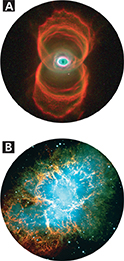As the dying star blows off much of its mass, only its hot core remains. This dense core is a white dwarf. A white dwarf is about the same size as Earth but has about the same mass as the sun. White dwarfs don't undergo fusion, but glow faintly from leftover thermal energy. It takes about 20 billion years for a white dwarf to cool down completely. The universe hasn't been here long enough for this to happen yet.
High-Mass Stars
The life cycle of high-mass stars (those with a mass of more than eight times that of the sun) is very different from the life cycle of lower-mass stars. As high-mass stars evolve from hydrogen fusion to the fusion of other elements, they grow into brilliant supergiants. This creates new elements, the heaviest being iron. A highmass star dies quickly because it consumes fuel very rapidly.
As fusion slows in a high-mass star, pressure decreases. Gravity eventually overcomes the lower pressure, leading to a dramatic collapse of the star's outer layers. This collapse produces a supernova, an explosion so violent that the dying star becomes more brilliant than an entire galaxy. Supernovas produce enough energy to create elements heavier than iron. These elements, and lighter ones such as carbon and oxygen, are ejected into space by the explosion. The heavier elements in our solar system, including the atoms in your body, came from a supernova that occurred in our galaxy billions of years ago.

What is a supernova?
Figure 18 Nebulas are associated with the birth and death of stars. A Planetary nebulas, such as the Hourglass Nebula, are clouds of gas that surround a collapsing red giant. B The Crab Nebula is the remnant of a supernova explosion that was observed on Earth in A.D. 1054. The supernova was so bright that people could see it in the daytime.





